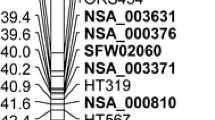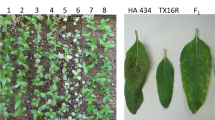Abstract
Pre-emptive breeding for host disease resistance is an effective strategy for combating and managing devastating incursions of plant pathogens. Comprehensive, long-term studies have revealed that virulence to the R 2 sunflower (Helianthus annuus L.) rust resistance gene in the line MC29 does not exist in the Australian rust (Puccinia helianthi) population. We report in this study the identification of molecular markers linked to this gene. The three simple sequence repeat (SSR) markers ORS795, ORS882, and ORS938 were linked in coupling to the gene, while the SSR marker ORS333 was linked in repulsion. Reliable selection for homozygous-resistant individuals was efficient when the three markers, ORS795, ORS882, and ORS333, were used in combination. Phenotyping for this resistance gene is not possible in Australia without introducing a quarantinable race of the pathogen. Therefore, the availability of reliable and heritable DNA-based markers will enable the efficient deployment of this gene, permitting a more effective strategy for generating sustainable commercial cultivars containing this rust resistance gene.



Similar content being viewed by others
References
Allard RW (1956) Formulas and tables to facilitate the calculation of recombination values in heredity. Hilgardia 24:235–278
Bassam BJ, Caetano-Annollés G (1993) Silver staining of DNA in polyacrylamide gels. Appl Biochem Biotechnol 42:181–188
Beckman JS, Soller M (1983) Restriction fragment length polymorphisms in genetic improvement: methodologies, mapping and costs. Theor Appl Genet 67:35–43
Engel BC, Aitken EA, Goulter KC, Gulya T, Kong GA, Kochman JK (1998) Genetic diversity among global isolates of sunflower rust revealed by genetic markers. In: Proceedings of the 7th international congress of plant pathology, Edinburgh, Scotland
Gulya TJ (1985) Registration of five disease-resistant sunflower germplasms. Crop Sci 25:719–720
Haley SD, Afanador L, Kelly JD (1994) Selection for monogenic pest resistance traits with coupling- and repulsion-phase RAPD markers. Crop Sci 34:1061–1066
Johnson E, Miklas PN, Stavely JR, Martinez-Cruzado JC (1995) Coupling- and repulsion-phase RAPDs for marker-assisted selection of PI 181996 rust resistance in common bean. Theor Appl Genet 90:659–664
Kochman JK, Goulter KC (1984) The occurrence of a second race of rust (Puccinia helianthi in sunflower crops in eastern Australia. Australas Plant Pathol 13:3–4
Kong GA, Goulter KC, Kochman JK, Thompson SM (1999) Evolution of pathotypes of Puccinia helianthi on sunflower in Australia. Australas Plant Pathol 28:320–332
Lambrides CJ, Miller JF (1994) Inheritance of rust resistance in a source of MC29 sunflower germplasm. Crop Sci 34:1225–1230
Lawson WR, Henry RJ, Kochman JK, Kong GA (1994) Genetic diversity in sunflower (Helianthus annuus L.) as revealed by random amplified polymorphic DNA analysis. Aust J Agric Res 45:1319–1327
Lawson WR, Goulter KC, Henry RJ, Kong GA, Kochman JK (1998) Marker assisted selection for two rust resistance genes in sunflower. Mol Breed 4:227–234
Litt M, Luty JA (1989) A hypervariable microsatellite revealed by in vitro amplification of a dinucleotide repeat within the cardiac muscle actin gene. Am J Hum Genet 44:397–401
Manly KF, Cudmore RH Jr, Meer JM (2001) Map Manager QTX, cross platform software for genetic mapping. Mamm Genome 12:930–932
McIntosh RA, Brown GN (1997) Anticipatory breeding for resistance to rust diseases in wheat. Annu Rev Phytopathol 35:311–326
Miah MAJ, Sackston WE (1970) Genetics of rust resistance in sunflowers. Phytoprotection 51:1–16
Michelmore RW, Paran I, Kesseli RV (1991) Identification of markers linked to disease resistance genes by bulked segregant analysis: a rapid method to detect markers in specific genomic regions using segregating populations. Proc Natl Acad Sci USA 88:828–9832
Putt ED, Sackston WE (1963) Studies on sunflower rust. IV. Two genes, R 1 and R 2 for resistance in the host. Can J Plant Sci 43:490–496
Quresh Z, Jan CC, Gulya TJ (1993) Resistance to sunflower rust and its inheritance in wild sunflower species. Plant Breed 110:297–306
Roath WW, Miller JF, Gulya TJ (1986) Registration of sunflower parental lines HA 821 and HA 822. Crop Sci 26:217
Sackston WE (1962) Studies on sunflower rust. III. Occurrence, distribution, and significance of races of Puccinia helianthi Schw. Can J Bot 40:1449–1458
Schneiter AA, Miller JF (1981) Description of sunflower growth stages. Crop Sci 21:901–903
Sendall BC, Kong GA, Goulter KC, Atiken EAB, Thompson SM, Mitchell JHM, Kochman JK, Lawson W, Shatte T, Gulya TJ (2006) Diversity in the sunflower: Puccinia helianthi pathosystem in Australia. Australas Plant Pathol 35:657–670
Tang S, Yu J-K, Slabaugh MB, Shintani DK, Knapp SJ (2002) Simple sequence repeat map of the sunflower genome. TheorAppl Genet 105:1124–1136
Vos P, Hoger R, Bleeker M, Reijans M, Van de Lee T, Hornes M, Frijters A, Pot J, Peleman J, Kuiper M, Zabeau M (1995) AFLP: a new technique for DNA fingerprinting. Nucleic Acids Res 23:4407–4414
Welsh J, McClelland M (1990) Fingerprinting genomes using PCR with arbitrary primers. Nucleic Acid Res 18:7213–7218
Williams JGK, Kubelik AR, Livak KJ, Rafalski JA, Tingey SV (1990) DNA polymorphisms amplified by arbitrary primers are useful as genetic markers. Nucleic Acids Res 18:6531–6535
Yang SM (1986) A new race of Puccinia helianthi in sunflower. Ann Phytopathol Soc Jpn 52:248–252
Yu J-K, Tang S, Slabaugh MB, Heesacker A, Cole G, Herring M, Soper J, Han F, Chu W-C, Webb DM, Thompson L, Edwards KJ, Berry S, Leon AJ, Grondona M, Olungu C, Maes N, Knapp SJ (2003) Towards a saturated molecular genetic linkage map for cultivated sunflower. Crop Sci 43:367–387
Zeitkiewicz E, Rafalski A, Labuda D (1994) Genome fingerprinting by simple sequence repeat (SSR)-anchored polymerase chain reaction amplification. Genomics 20:176–183
Acknowledgments
The authors wish to acknowledge the financial support of the Grains Research and Development Corporation, the former Cooperative Research Centre for Tropical Plant Pathology, and the Queensland Government.
Author information
Authors and Affiliations
Corresponding author
Additional information
© State of Queensland, Department of Employment, Economic Development and Innovation, 2010.
Rights and permissions
About this article
Cite this article
Lawson, W.R., Jan, C.C., Shatte, T. et al. DNA markers linked to the R 2 rust resistance gene in sunflower (Helianthus annuus L.) facilitate anticipatory breeding for this disease variant. Mol Breeding 28, 569–576 (2011). https://doi.org/10.1007/s11032-010-9506-1
Received:
Accepted:
Published:
Issue Date:
DOI: https://doi.org/10.1007/s11032-010-9506-1




